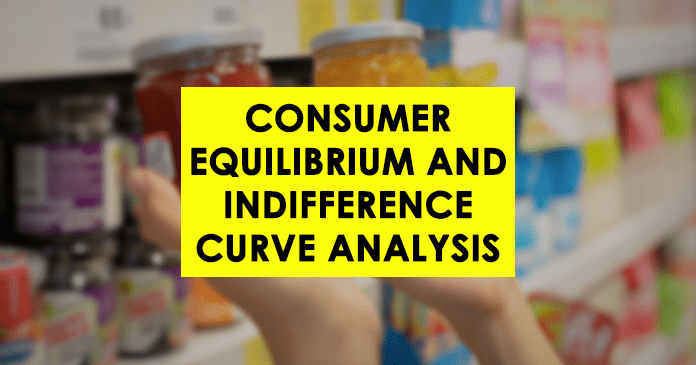Consumer equilibrium and indifference curve analysis are interconnected concepts. Because, under the indifference curve analysis, a rational customer’s equilibrium is analyzed. So what is indifference curve analysis?
The previous article discussed indifference curvet analysis.
You can check it here.
After reading this article, you will learn about:
- What is consumer equilibrium
- How to derive consumer equilibrium?
- Budget line
- Change of Consumer Equilibrium
- What is Engle Curve?
- What is Engle’s Law?
Consumer equilibrium
The consumer wants so many goods. Although a consumer needs various quantities of different commodities to consume at a time, consumers cannot buy all commodities. His income is not enough to buy all the goods. This means that income acts as a constraint in maximizing utility.
Thus, consumer equilibrium can consider as a constrained utility maximization problem.
Income constraint shows the relationship between fixed income and expenditure. So for ‘n’ commodity case income constraint takes the form of M = P1Q1 + P2Q2 +….+ PnQn.
Before learning about consumer equilibrium, we must know about what is the budget line. So let’s look at the budget line next.
Budget line and indifference curve
The budget line can define as,
The locus of all combinations of two (or more) commodities, can be purchased with given money income and commodity prices.
Suppose there are two commodities (X and Y).
- Income constraint is, M = PXQX + PYQY
- M = money income
- PX = price of commodity X
- PY = price commodity Y
- QX = quantity of commodity X
- QY = quantity of commodity Y
We can present this income constraint graphically by the budget line. Let’s see
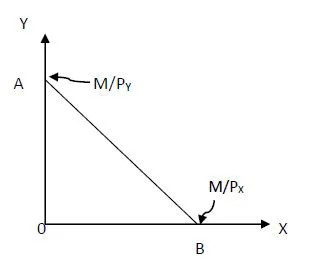
With the given income (M) and commodity prices, we may find Qy’s corresponding values by assigning successive values for Qx.
For example when
- Qx = 0 consumer can buy M/Py of Y. Similarly, if
- QY = 0 consumer can buy M/PX units of X.
By inserting these points in a two-dimensional plane, we may construct the budget line as above.
When the budget line touches the indifference curve, that point gives the highest utility.
The touchpoint is the consumer equilibrium point.
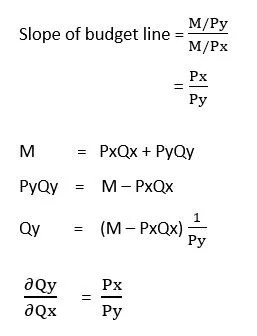
The above equation proves that the slope of the budget line is the ratio of the two commodities’ prices.
The slope of the budget line = Price ratio
Derivation of the Consumer Equilibrium
The consumer is in equilibrium when he maximizes his utility, given his money income and commodity prices. In other words, a consumer is in equilibrium when he reaches the highest possible indifference curve, given his salary and commodity prices.
In analyzing consumer equilibrium, we assume that.
- Indifference curve main which shows the preference of the consumer is given
- Consumer preference remain unchanged
- Gives income and prices of goods
- The goal of the consumer is to maximize utility on the given income
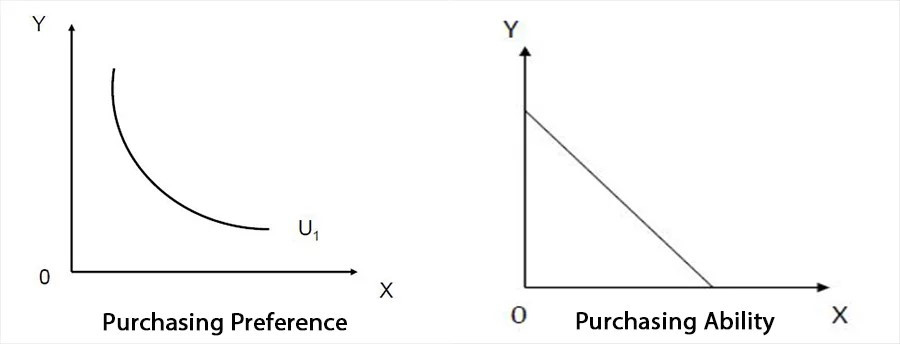
For the equilibrium,
Preference = Ability
Consumer Equilibrium in Graphically
The indifference curve map shows the consumer’s preference and budget constraint. So the equilibrium defines by the point of tangency of the budget line with the highest possible indifference curve.
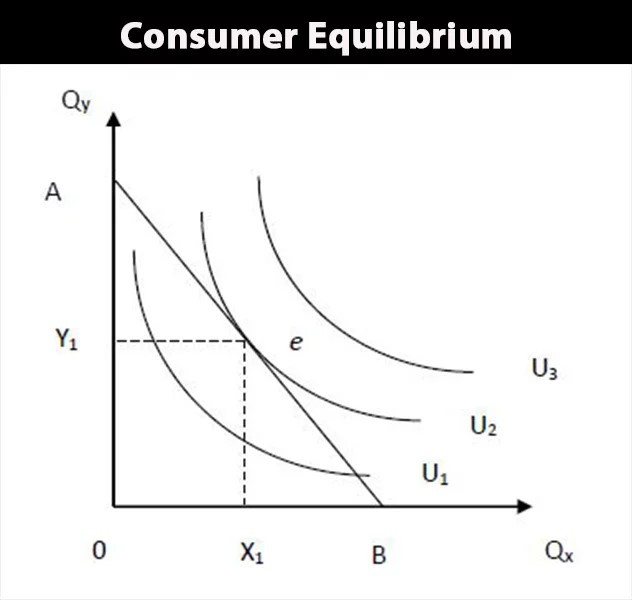
The consumer is in equilibrium at point ‘e’ where the budget line touches the U2 indifference curve. Although the consumer is willing to go to the U3 indifference curve, his limited income does not allow him to do so. At point e, the slope of the budget line (Px/Py) equals the slope of the indifference curve.
Conditions of consumer equilibrium in indifference curve analysis?
The slope of the indifference curve, MRS = Mux/Muy = Px/Py
Mux/Px = Muy/Py
Thus, the first-order condition or necessary condition for the equilibrium. This says that the last unit of money spent on each commodity must bring him the same marginal utility. It also called ”The principle of Equi-marginal utility.”
But fulfilling this condition is not sufficient because it does not ensure the equilibrium always. The second-order or sufficient condition is that at the tangency point indifference curve must be convex towards the origin.
- first-order condition or necessary condition – Mux/Px = Muy/Py
- second-order or sufficient condition – at the tangency point indifference curve must be convex towards the origin.
Equilibrium condition in mathematical form
Utility function is U = f (x,y)
Budget constrain is M = PxQx + PyQy
Consumer equilibrium is a constrained maximization problem. It can write formally as,
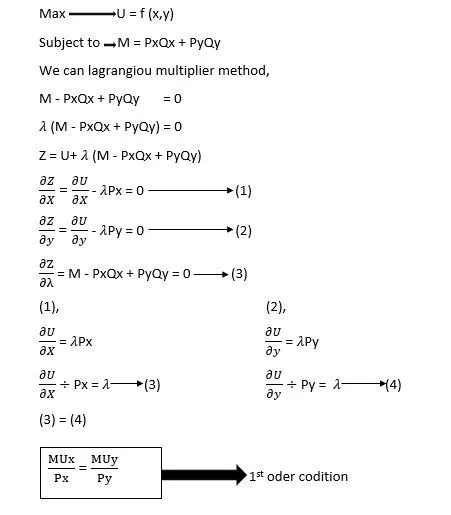
Change of Consumer Equilibrium
In analyzing the consumer equilibrium, we assumed that,
- Gives income and prices of goods
- Consumer preference remain unchanged
If at least one of these conditions changes, consumer equilibrium also will change. Change of both these factors affects the budget constraint. If the income of the consumer change, keeping prices of commodities constant, the position of the budget line will change, keeping its shape unchanged.
For example
when income increase, the purchasing power of the consumer also increases. As a result budget line will shift upward parallel to the original budget line. The slop of the budget line will not change since the prices of commodities remain unchanged. On the contrary, when the income decreases, the budget line will shift downward, parallel to the first budget line (see below).
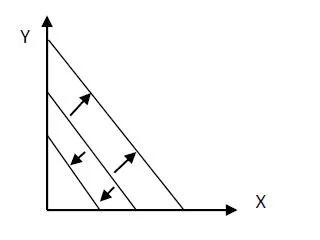
On the other hand, when prices of commodities change, keeping income constant, a position, as well as slope of the budget line, will change.
If prices of both commodities change by the same proportion in the same direction, the budget line will shift parallel to the original line. But, if they vary by different proportions, the slope of the budget line will also change.

If the price of one commodity, say X, change keeping income and price of another commodity (say Y) constant in two commodity cases, the budget line will oscillate along the axis that price changed with fixed to the axis that price kept constant (see above).
Income Change and Consumer Equilibrium
The analysis of the effect of change of all these factors on consumer equilibrium is very complicated. Thus, for simplicity, firstly, we will examine the impact of the change of consumer income on the equilibrium. In this case, prices of the commodities and consumer, preferences remain constant.
When income change keeping other factors constant, the budget line will shift upward or downward.
For example
when the income of the consumer increases, the budget line shifts upward, implying increasing the purchasing power. The shift of budget line would parallel since we keep the prices of the commodities constant. The new equilibrium point will place on a higher indifference curve. Consumers will get a higher level of satisfaction.
Income consumption curve (ICC)
Let’s discuss what income consumption curve is.
Budget lines have shifted upward as a result of the rise of income. The new equilibrium has occurred at the points in which those shifted lines touch the indifference curves giving him higher satisfaction. The line or curve formed by joining these equilibrium points is called ‘income consumption curve – ICC.’
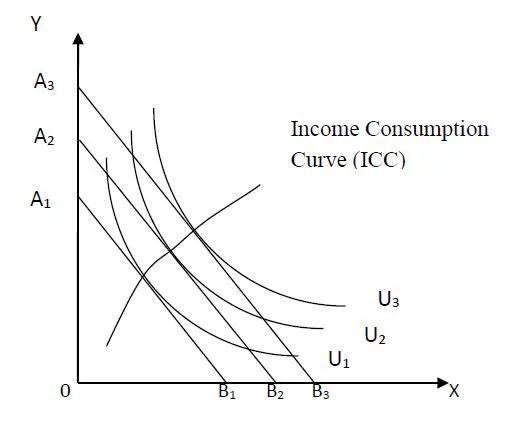
ICC shows,
how consumer equilibrium has changed when his income rises.
ICC may be a straight line or a curve depending on the consumer’s preference for the goods.
Shapes of Income consumption curve (ICC)
The shape of ICC depends on the nature of goods. Theoretically,
- The goods that the demand increases at a higher rate than the increase in income are called luxury goods.
- The goods that the demand increases at a lower rate than the increase in income are called necessary or normal goods.
- If the demand for a commodity decrease when the income increase, it is an inferior good.
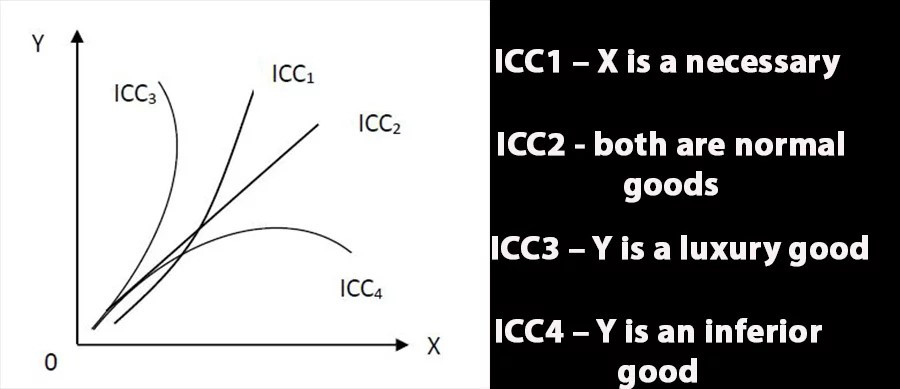
ICC angled towards one of the axes, the commodity represented by the axis is considered as a ‘luxury.’
ICC positively slope without leaning any axis; both commodities are ‘normal.’
ICC positively slope up to a specific range of income increase and then negatively sloped, the commodity represents the axis which ICC deviated away is an ‘inferior’ good.
Engle Curve (EC)
Engle curve shows the relationship between consumer’s income and the quantity consumed, prices being constant.
This name for the curve gives as an honour to the Prussian economist Ernest Engle (1821-1946), who first studied the household income-consumption relationship.
According to him, in the case of luxury goods, the demand increases proportionately more rapidly than income,. And also, for inferior goods, the demand increases proportionately less quickly than income. This is known as the ‘Engle’s Law.’
We can derive EC from the ICC. Let’s see.
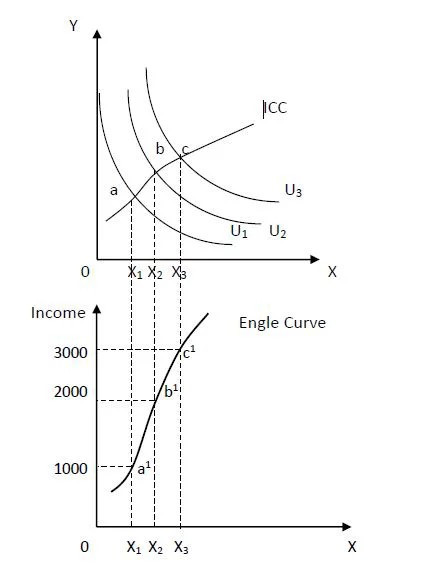
EC may take different shapes depending on the income-consumption relationship for commodities. The few different shapes of the EC are below:
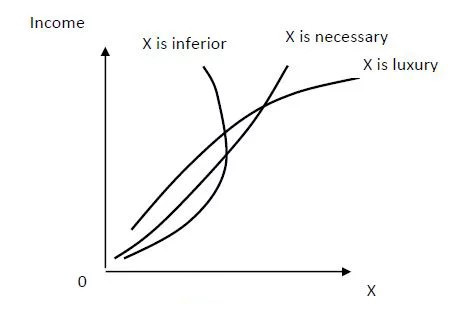
Questions
1. What are the conditions of consumer equilibrium in indifference curve analysis?
2. What is Consumer Equilibrium explain with diagram?
3. What do you mean by consumer equilibrium?
4. What is Consumer equilibrium with example?
5. What is the Engel curve in economics?
6. What is an Engel curve? How is the Engel curve derived from the income consumption curve?
7. Explain the consumer equilibrium position in the framework of indifference curve analysis. Derive the necessary and sufficient conditions graphically or mathematically.
I think the answers to these questions can found in this article. If there is any problem, leave a comment. I’m here to support you.
Further Reading
Consumer equilibrium and indifference curve analysis
Consumer equilibrium and utility analysis
What is Indifference Curve: Definition, Assumptions, Properties
Isoquant curve analysis of production in economics
Indifference Curve Questions and Answers
What is a Budget Line| Definition, Properties, Equation
Conclusion
All right then. In this article, we discussed What is consumer equilibrium, how to derive it, budget line, change of consumer equilibrium, engle curve, and engle’s law. Did I miss anything?
Let me know by leaving a comment below and ask questions.


